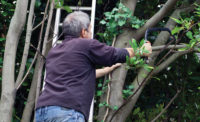Lessons in ladder safety 101

This is not the ISHN editor in action
Rain came down in buckets one evening this summer, a torrential storm. The next morning branches from one of our apple trees had sheared off and weighed down a neighbor’s backyard telephone and electrical wires.
The safest thing would have been to call in a landscaper or tree cutting service. Of course safety costs money, and I had the common DIY reaction: I can do this.
Or so I thought. I don’t have to tell you, ladder climbing is dangerous. Each year more than 90,000 people receive emergency treatment for ladder-related injuries, according to the Consumer Product Safety Commission (CPSC). And the risk is getting worse: in the past ten years ladder-related injuries have increased 50 percent. One contributing factor: aging baby boomers like your editor thinking they can scoot up and down ladders like they did 30 years ago.
Woulda, coulda, shoulda
Of course I should have Googled “ladder safety” before I attempted to climb up and saw off the branches weighing down my neighbor’s wires. But I was in a rush. The job would be a pain. It was damn hot. So there was no pre-job safety briefing.
The CPSC says the number one cause of ladder injuries is choosing the wrong ladder. Which is precisely what I did. A six-foot aluminum step ladder proved to be too short and would have had me standing on the very top rung to reach the branches. This is completely at odds with the three-points-of-contact rule: whenever you’re on a ladder you should have either both feet and one hand on the rungs, or both hands and one foot to secure you.
So I borrowed my neighbor’s heavy-duty aluminum extension ladder, which folded out to be a good 20 feet long. It was relatively new and not worn or damaged. Using worn or damaged ladders is the second leading cause of ladder injuries.
Incorrect use of ladders is the third leading cause of accidents. CPSC warns, “Never use a ladder in any other way than what the manufacturer intended it to be used for.” I didn’t bother to read the fine print on the ladder. Looking back, I wonder if the manufacturer explicitly warned against using this 20-foot extension ladder to cut down tree branches. Oh well…
The need for an attendant
Incorrect ladder placement is the fourth leading cause of injuries, according to the CPSC. Using a ladder to get into a tree is not as simple as leaning it against a wall or the edge of a roof. Judgment and risk assessment definitely come into play. I recommend consulting a second opinion. Almost every use of a ladder around the house or at work should be a two-person job. One is the ladder climber, the other the ladder attendant — similar to a confined space attendant standing outside the space, ready to act quickly if something goes awry.
My personal ladder attendant, my wife, and I surveyed the apple tree, trying to figure the most stable placement. That includes being secure at the base, on the ground — no mud or water or uneven surface — as well as being secure at the top, wedged between two thick branches to support the ladder and prevent any movement.
After some deliberation, we secured the ladder and up I went, with a hand saw. The American Ladder Institute would be proud that I followed many of its basic ladder safety rules — although I only learned of them afterward in researching this editorial. I did not feel tired climbing the ladder. I wasn’t using a ladder outdoors in high wind or stormy conditions. I made sure I didn’t have mud or anything slippery on the bottom of my shoes. I definitely moved slow, paid serious attention, and was cognizant of “the user’s age and physical condition.” Plus, I had confidence in my ladder attendant on the ground, directing my movements, making sure the ladder held steady.
Staying focused
All’s well that ends well — most of the time — when you’re mindful, cautious and have vivid memories of a previous bad accident — in my case a tumble in a ravine in the Badlands National Park a few years ago. I sawed off the branches and yanked the cut branches off the wires, dropped my saw to the ground, and slowly climbed down. Climbing a ladders is similar in one way to climbing a mountain — you assume the hardest part is getting to the top, but rushing to come back down is dangerous, too. It felt good to have both feet back on the soil. And I admit feeling a surge of adrenalin that comes when you safely pull off a job you know is a bit dangerous. Still, I wouldn’t do it again. I’d find a neighbor with a good, sharp saw blade mounted on an extension pole designed to clip branches from the ground.
Looking for a reprint of this article?
From high-res PDFs to custom plaques, order your copy today!







